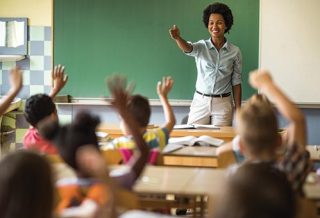FOCUS
A welcome space for taking risks
Psychological safety creates a positive climate for learning
By Shannon Wanless and Dana Winters
Categories: Social & emotional learningAugust 2018
Vol. 39 No. 4
Read the remaining content with membership access. Join or log in below to continue.
Sed ut perspiciatis unde omnis iste natus error sit voluptatem accusantium doloremque laudantium, totam rem aperiam, eaque ipsa quae ab illo inventore veritatis et quasi architecto beatae vitae dicta sunt explicabo. Nemo enim ipsam voluptatem quia voluptas sit aspernatur aut odit aut fugit, sed quia consequuntur magni dolores eos qui ratione voluptatem sequi nesciunt. Neque porro quisquam est, qui dolorem ipsum quia dolor sit amet, consectetur, adipisci velit, sed quia non numquam eius modi tempora incidunt ut labore et dolore magnam aliquam quaerat voluptatem.
EARLY CHILDHOOD EDUCATORS LEARN ABOUT MATH
In a National Science Foundation-funded project, early education teachers used Simple Interactions to improve their teaching of math and social-emotional skills. The teachers learned to engage with children using Peg + Cat, an animated math-based PBS television show accompanied by games and resources. They also participated in Simple Interactions learning sessions that included video clips of them working with children on the math resources.
Reflecting on the experience, one teacher said, “I learned from seeing myself up there that what I am doing is what I am supposed to be doing. It’s so different to see yourself doing something positive. It’s a good thing.”
A school director said, “It was so nice to know that what we do is validated. … What we do does matter.” This group of educators, from four different schools, did not know each other before the project but were able to use the safety and trust built within the group to explore practices and learn from one another.
References
Akiva, T., Li, J., Martin, K.M., Horner, C.G., & McNamara, A.R. (2016). Simple Interactions: Piloting a strengths-based and interaction-based professional development intervention for out-of-school time programs. Child & Youth Care Forum, 46(30), 285-305.
Coyle, D. (2018). The culture code: The secrets of highly successful groups. New York, NY: Bantam.
Edmondson, A. (1999). Psychological safety and learning behavior in work teams. Administrative Science Quarterly, 44(2), 350-383.
Edmondson, A.C. & Roloff, K.S. (2009). Overcoming barriers to collaboration: Psychological safety and learning in diverse teams. In E. Salas, G.F. Goodwin, & C.S. Burke, Team effectiveness in complex organizations: Cross-disciplinary perspectives and approaches. New York, NY: Routledge.
Foldy, E.G., Rivard, P., & Buckley, T.R. (2009). Power, safety, and learning in racially diverse groups. Academy of Management Learning & Education, 8(1), 25-41.
Pascale, R., Sternin, J., & Sternin, M. (2010). The power of positive deviance: How unlikely innovators solve the world’s toughest problems. Boston, MA: Harvard Business Press.
Wanless, S.B. (2018, June). Psychological safety as an element of readiness to implement. In K. Maxwell (Chair), “Readiness for Change” in early learning: What is it? How do we measure it? And what are we learning? Symposium at the National Research Conference in Early Childhood, Washington, D.C.
Wanless, S.B. (2016). The role of psychological safety in human development. Research in Human Development, 13(1), 6-14.
Watson, W.E., Kumar, K., & Michaelsen, L.K. (1993). Cultural diversity’s impact on interaction process and performance: Comparing homogeneous and diverse task groups. Academy of Management Journal, 36(3), 590-602.
Categories: Social & emotional learning
Recent Issues
LEARNING TO PIVOT
August 2024
Sometimes new information and situations call for major change. This issue...
GLOBAL PERSPECTIVES
June 2024
What does professional learning look like around the world? This issue...
WHERE TECHNOLOGY CAN TAKE US
April 2024
Technology is both a topic and a tool for professional learning. This...
EVALUATING PROFESSIONAL LEARNING
February 2024
How do you know your professional learning is working? This issue digs...










